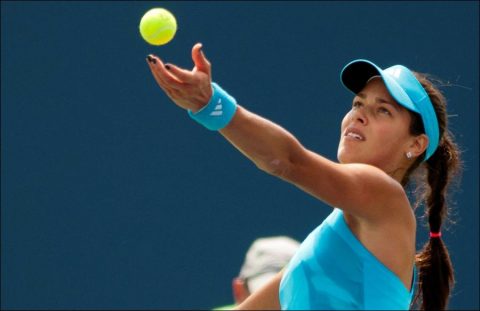This is the big gun of tennis. Here, more than anywhere else, brute force and sheer power pay off. I do not mean that there is no place for brains, for there is in mixing in the slow angle, but most overheads are won by the speed of the shot alone.
The technique of the smash is simple. Model it on the cannonball service.
1. Keep your eye on the ball until you hit it. More overheads are missed because a player looks down just before he hits the ball and, by so doing, pulls his racquet head off the line of his shot, than for any other cause.
2. Turn sideways and, even if the ball is a little to the left of your head, hit it as a forehand. There is no such shot as a backhand overhead.
3. Keep at least one foot on the ground and do not rotate your body to face the court until you have hit the ball, but lean into your shot as you hit.
4. Take a full arm swing and be sure that the racquet head is travelling ahead of your hand at the moment the ball is hit.
5. Hit absolutely flat, directly at the point you want the ball to go, and continue your swing to the very end of the racquet head are, down to below your knees.
The overhead is always an attacking shot in theory, and it should be hit with great decision. Only if a ball is so high and deep that you must jump to reach it should it be played defensively. Many players, such as Borotra, Cochet, Gonzales, Bob Falkenberg, and Kramer, go all out for their kill, even when leaping off the ground with both feet. No matter how far back you may be driven by a lob, you must always lean forward into your smash as you make it.
Once more I must stress that it is the racquet he ad and the speed of its swing that give the power and pace to the stroke. Great overheads are made with little or no body movement, no convulsive efforts, and an apparent ease that belies the power of the shot. The overhead is almost the only shot, except possibly the cannonball service, in which height is a great asset. However, it is not an absolute essential, as proved by Henri Cochet, a man of medium height but the possessor of one of the finest overheads in tennis history. It is the fluid swing of Cochet’s racquet head that gives him his power.
Almost always, whenever the overhead can be used, it should be hit with destructive force. However, there are certain remarkable baseline players who can get to practically any shot hit deep, and put even the best fast overhead back into play. Frank Parker, Bobby Riggs, and Carl Earn are such players. When you’re up against a “getter” of this sort, there comes a time to vary your tactics and bring in the slow, short, sharply angled overhead.
If you have hit a couple of deep, fast overheads only to see them lobbed back high in the air, on the next one take the same preparation, but instead of swinging hard at the ball, bring the racquet against it on one side surface or the other of the ball. Make a sharp angle and block the ball as in a volley, off to the side instead of swinging through. This shot is valuable on day or grass, since it will stay short, but on hard courts it is very dangerous to try.
Under any circumstances, if you try it, follow your shot and close off the straight passing shot, for your opponent, if not caught napping by surprise, may reach it.
The whole story of the net game is attack. The net game has great strategic value if used intelligently at the right times, even though it is certainly not a game to play all the time, or thoughtlessly. If you have little else in your stroke equipment, you must fail a large percentage of the time. All your opponent needs is a sound enough defence to cope with your net game, and enough attack of his own to keep you away from the net part of the time.
Yet I consider the net game absolutely essential to every tennis player’s equipment. All I hope is that he will not be carried away by its flashiness, and give it overemphasis.
There is always an answer to anything, and I have attempted to show that in the ground stroke lies the answer to the net game.
